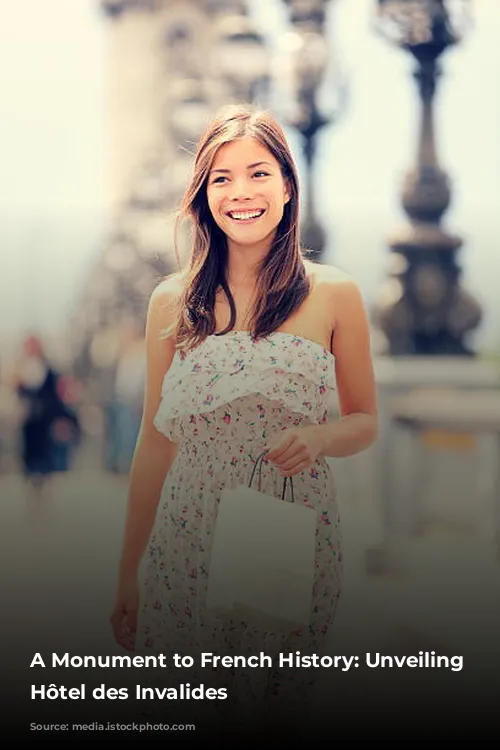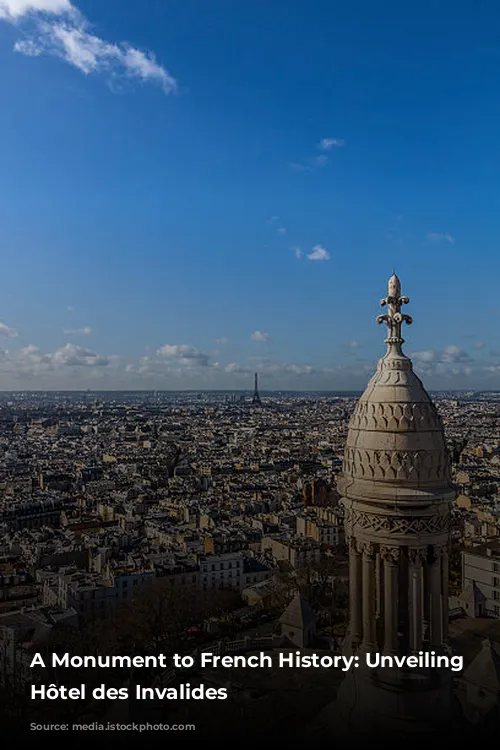The Hôtel des Invalides stands proudly in Paris’s 7th arrondissement, a monument to French military history and a testament to the nation’s rich heritage. More than just a building, it’s a complex of museums, churches, and monuments that offer a captivating glimpse into France’s past. You’ll be drawn to the iconic golden dome, the final resting place of the legendary Napoleon Bonaparte.
Getting There: A Simple Journey
This architectural masterpiece is conveniently located near the Seine River in the heart of Paris. Reaching it is a breeze, with several public transport options at your disposal. Hop on metro lines 8 and 13 at the Invalides station, or choose line 8 at La Tour-Maubourg or line 13 at Varenne. Various bus lines also connect the area.
A Royal Vision: The Origins of the Hôtel des Invalides
The Hôtel des Invalides was commissioned by King Louis XIV in 1670 as a sanctuary for wounded soldiers. This grand project was a key part of the king’s ambition to strengthen and centralize the French military. Architect Liberal Bruant brought the vision to life, completing the impressive complex in 1676.
Echoes of the Past: A Historic Witness
Beyond its role as a military hospital, the Hôtel des Invalides has witnessed significant historical events. During the tumultuous French Revolution, the complex was a pivotal site. Revolutionaries seized cannons and muskets from the Invalides before their iconic assault on the Bastille in 1789.
A Transformation: From Hospital to Monument
Over time, the Hôtel des Invalides has evolved from its original purpose as a military hospital to a collection of museums and monuments. Today, it houses the Musée de l’Armée, the Musée des Plans-Reliefs, and the Musée de l’Ordre de la Libération. You’ll also find several churches, and, of course, the magnificent Dome des Invalides, the resting place of Napoleon Bonaparte.
Architectural Grandeur: French Baroque Elegance
The Hôtel des Invalides is a breathtaking example of French Baroque architecture. Fifteen courtyards make up the complex, the most prominent being the Cour d’Honneur. The buildings exude a classical simplicity, with a consistent aesthetic featuring red brick and stone facades, slate roofs, and dormer windows.
The Golden Dome: A Symbol of Power
The Dome des Invalides, with its majestic 107-meter height, is a defining feature of the Hôtel des Invalides. Initially conceived as a royal chapel by Jules Hardouin-Mansart, one of the most influential French architects of the 17th century, the dome was later transformed to accommodate the tomb of Napoleon Bonaparte.
The Cour d’Honneur: A Courtyard of Honor
The Cour d’Honneur, or Court of Honor, is the heart of the complex. Surrounded by two-story buildings once used as soldiers’ quarters, it now serves as a stage for military parades and ceremonies, a spectacle of French military tradition.
Exploring History: The Musée de l’Armée
The Musée de l’Armée, or Army Museum, is one of the world’s largest military museums. It’s a treasure trove of military artifacts, from weapons and armor to uniforms and artwork. The collection encompasses history from antiquity to the 20th century, offering a comprehensive view of France’s military past.
Napoleon’s Resting Place: The Tomb of a Legend
Beneath the Dome des Invalides lies the tomb of Napoleon Bonaparte, one of France’s most celebrated figures. His remains were returned to France from Saint Helena in 1840 and placed in a grand sarcophagus in the crypt under the dome.
More Than Napoleon: Honoring French Military Heroes
Besides Napoleon, the Hôtel des Invalides is the final resting place for other prominent figures in French military history, including Napoleon’s brothers Joseph and Jérôme Bonaparte, Marshal Foch, and various governors and ministers of war.
Visiting the Complex: Ticket Information
While the courtyard of the Hôtel des Invalides is free to enter, there’s an admission fee for the museums and monuments within the complex. This includes the Army Museum, the Tomb of Napoleon, and other museums. Discounts are available for students, seniors, and groups. Entry is free for children under 18.
Ticketing Options: Online or On-Site
Tickets can be purchased at the ticket office on-site or online through the official website of the Army Museum.
Timing Your Visit: Avoiding the Crowds
The Hôtel des Invalides is open year-round, but summer months see a surge in visitors. To avoid the crowds, plan your visit for early morning or late afternoon. The complex is open from 10 am to 6 pm from April to October, and from 10 am to 5 pm from November to March.
Where to Stay: Accommodations Near the Hôtel des Invalides
There are many hotels near the Hôtel des Invalides, offering a range of options to suit every budget. Luxury travelers may prefer Hotel Le Walt, Hotel de Varenne, or Hotel Juliana Paris, all within walking distance of the Invalides.
Budget-conscious travelers can find affordable options like the Aloha Hostel and Hotel de la Paix Tour Eiffel. For an even more luxurious experience, Le Narcisse Blanc & Spa or Hotel d’Orsay offer top-notch amenities and services.
Beyond the Invalides: Exploring the 7th Arrondissement
The Hôtel des Invalides is situated in the 7th arrondissement, one of Paris’s most prestigious neighborhoods. This area is home to other famous attractions, including the Eiffel Tower, the Musée d’Orsay, and the Rodin Museum. Take a relaxing stroll along the Seine River, explore the bustling Rue Cler market street, or unwind in the Champ de Mars park.
Artistic Inspiration: The Rodin Museum
Just a short walk from the Hôtel des Invalides, the Rodin Museum is dedicated to the works of the renowned French sculptor Auguste Rodin. Here, you can admire his iconic sculptures, such as “The Thinker” and “The Gates of Hell”, set in a beautiful garden.
A Bridge of Beauty: The Alexandre III Bridge
The Alexandre III Bridge, considered one of Paris’s most beautiful bridges, is also close to the Hôtel des Invalides. Adorned with elaborate Art Nouveau lamps and sculptures, it offers stunning views of the Seine River and surrounding landmarks.
Iconic Landmarks Nearby: Eiffel Tower and Musée d’Orsay
The Eiffel Tower, a symbol of Paris, is easily accessible from the Hôtel des Invalides. Take a leisurely stroll along the Seine River or a short ride on the RER C train.
The Musée d’Orsay, housing a remarkable collection of Impressionist and Post-Impressionist masterpieces, is another must-visit attraction. The museum is located in a former railway station and features works by renowned artists like Monet, Renoir, and Van Gogh.
Shopping and Dining in the 7th Arrondissement
The 7th arrondissement offers a diverse range of shopping and dining experiences. From high-end fashion boutiques to charming antique shops, you’ll find something for every taste. For dining, there are numerous cafes, bistros, and restaurants, showcasing a wide variety of cuisines.
Other Parisian Gems: Louvre, Champs-Élysées, and the Seine River
The Louvre Museum, one of the world’s largest and most visited museums, is located a short distance from the Hôtel des Invalides. It boasts an extensive collection of art and historical artifacts, including the Mona Lisa and the Venus de Milo. The museum is easily reachable by metro or a pleasant walk along the Seine River.
The Champs-Élysées, known as the world’s most beautiful avenue, is another nearby attraction. This famous boulevard, stretching from the Place de la Concorde to the Arc de Triomphe, is lined with shops, cafes, and theaters. It’s an excellent place for a leisurely stroll or a shopping spree.
The Seine River, flowing through the heart of Paris, is an integral part of the city’s charm. A walk along the Seine offers breathtaking views of many of Paris’s most famous landmarks, including the Hôtel des Invalides, Notre-Dame Cathedral, and the Louvre. River cruises are also available, providing a different perspective of the city.
Conclusion: A Must-Visit Parisian Landmark
The Hôtel des Invalides is a must-visit for anyone interested in French history and architecture. From the stunning Dome des Invalides and the tomb of Napoleon Bonaparte to the extensive collections of the Army Museum, there’s something for everyone. Its central location makes it a convenient starting point for exploring other attractions in the 7th arrondissement and beyond.
Remember to check the opening hours of the museums and monuments within the complex, as they may vary. Also, be sure to wear comfortable shoes, as there’s a lot to see and do! Enjoy your visit to this historic and fascinating Parisian landmark!












